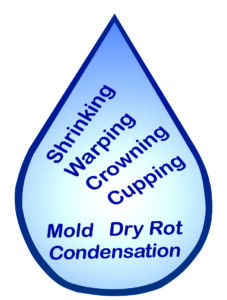Nobody would worry about moisture problems in wood, sheetrock and other building materials, if it would not be for:

— Shrinking, warping and cupping of wood-based products
— Deterioration from mold and related health hazards
Choose your topic of interest from the list below:
- What Causes Wood Moisture Problems?
- Shrinking, Warping, Cupping and the Perfect Board
- The Challenge of Hardwood Floors – Cupping and Crowning
- Laminated Panels and Engineered Floors
- Helpful Hints to Preventing Problems
- EMC Reference Table
- What is Mold and Why Avoid It?
Moisture Problems caused by Shrinking and Warping:
Surface checking, cracks and gaps, loose joints, delamination, foggy finishes, edge bending applications where the glue-line fails, cupped wood floors… None of the defects will occur, as long as the wood moisture content “matches” ambient relative humidity and temperature. For corresponding values see EMC Reference Table.
Problems caused by Mold:
Mold will grow almost anywhere, if enough moisture, enough food (wood, concrete, other organic matter), enough air and moderate temperatures are present. A sure way to prevent mold growth is to avoid high moisture conditions over extended periods of time. See Mold.
Key factors in preventing moisture problems are:
- Using materials at the right moisture content.
- Allowing enough time for acclimation
- Installing materials properly with the correct vapor barriers (if needed).
- And finally, maintenance is important.
- In case of water damage, repair should be done quickly.

